Medicine for nausea for a 3 year old child. Antiemetic drugs for children in a home medicine cabinet
By and large, vomiting is a normal reaction of the child’s body to the penetration of harmful substances into the gastrointestinal tract, which the stomach tries to immediately get rid of. Its goal is to cleanse the body of toxins and causative agents of painful spasms. And our goal as parents is to prevent dehydration of the child’s body and calm stomach cramps.
What is the right thing for parents to do in this case? Should I give my child something to stop vomiting? Which antiemetic drug for children will be most effective? Let's look into these issues together.
Most often, vomiting in young children occurs due to food poisoning. Food, water, and everything we consume is not sterile. The surface of food is a normal habitat for billions of different bacteria, and they, of course, get inside us every day. But nothing further happens, because our body has a natural arsenal of means to neutralize harmful microbes.
However, a person, in turn, has a lot of opportunities and ways to bypass these protective functions of the body. These include:
- poor chewing of food, swallowing in large pieces;
- overeating;
- neutralization of gastric juice with alkaline drinks;
- dirty hands;
- non-compliance with food storage rules;
- insufficient temperature treatment of products.
One way or another, when harmful bacteria enter the stomach, they disrupt digestion and cause inflammation of the intestinal mucosa. One of the causative agents of intestinal infection is rotavirus. It can be assumed that it is called that because it enters the body through the mouth. But this is a mistaken opinion. Its name comes from the Latin rota - wheel, as this virus is shaped like a wheel.
Read also:
As already mentioned, with the help of vomiting, the body protects itself from intestinal infection and tries to get rid of unwanted fauna. You should not interrupt this process at the very beginning; on the contrary, you need to provide all possible assistance - rinse the stomach. To do this, you need to consume more fluids. However, not all children agree to drink a lot when vomiting. In this case, you can invite the child to drink a little, but more often, or resort to using an enema.
An antiemetic for children with rotavirus is prescribed by a doctor if the measures taken to lavage the stomach do not give the expected effect.

With prolonged vomiting, there is a danger of dehydration and exhaustion of the body. To prevent this, antiemetic drugs are used. Such drugs, as a rule, have a narrowly targeted effect on various systems and organs:
- have an effect on nervous activity, in particular, block dopamine and serotonin receptors;
- act as local anesthetics, relieving spasms and stopping reflex contractions of the stomach muscles;
- block the action of active chemicals of the autonomic system, through which impulses are transmitted from nerve endings to muscles.
Today, pharmacies offer many drugs with antiemetic effects. Most of them do not require a prescription, which does not mean the possibility of self-medication, especially when it comes to the health of a child. Using a drug just because a neighbor recommended it may not only not improve the patient’s condition, but also harm him. For example, antiemetic neuroleptics may stop vomiting, but they will put the patient into a depressive state. They may cause slower reactions, drowsiness, dry mouth, or lower blood pressure. Doctors do not recommend taking such drugs to children under 15 years of age.
Let's look at the pharmacological agents that pediatricians usually prescribe for the treatment of intestinal infections in children.
Cerucal for vomiting
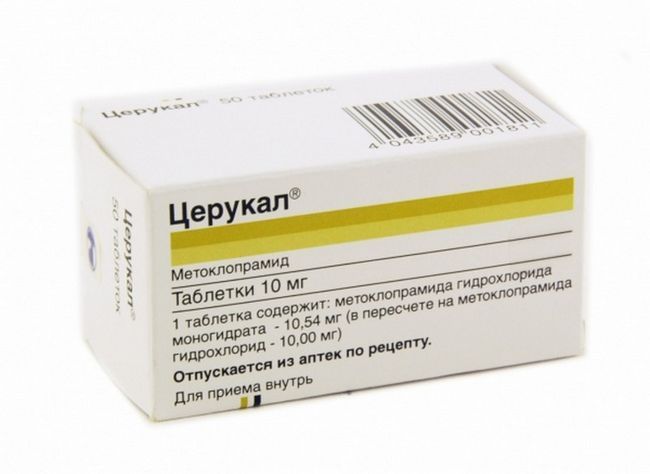
The active ingredient of Cerucal is metoclopramide. This substance blocks the action of serotonin and dopamine receptors, and also suppresses nerve impulses in the brain. As a result, the tone of the gastrointestinal tract muscles is normalized and the gag reflex is eliminated.
The medicine is produced in the form of injections and tablets. It is recommended to take this drug per day in an amount not exceeding 25 mg of the active substance. Its use is not indicated for children under three years of age, due to the fact that metoclopramide hydrochloride has a negative effect. side effect on health at this age. Cerucal is taken half an hour before meals.
Motilium for children
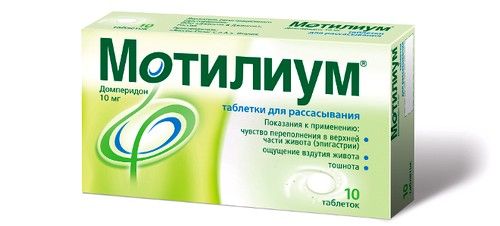
The active substance of this drug is domperidone. This antiemetic is taken 20 minutes before meals and is quickly absorbed. Dosage form: tablets and suspensions for oral administration. In the form of a suspension, the drug is approved for children from birth. Tablets are indicated only when the child's weight is above 35 kg.
Enterofuril for children
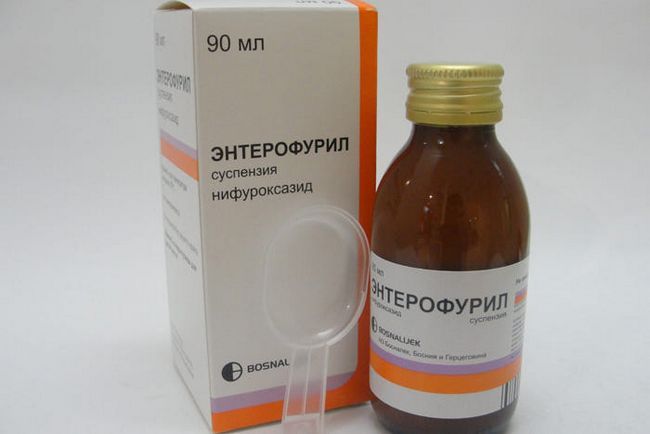
An antimicrobial agent whose active ingredient is nifuroxazide. Available in the form of capsules with a soluble shell and suspension. Recommended for children from one month. Up to seven years of age, it is taken in the form of a suspension. The dosage is selected individually depending on the age category. The drug is not absorbed by the body, so it is not recommended to combine it with taking sorbents for vomiting and diarrhea. The main side effect is that this drug causes dysbacteriosis.
Read also:
In conclusion, one more recommendation. The vomiting will definitely stop. When your child feels better, do not rush to feed him pickles. Start with a simple one - gelatin jelly. This product is rich in carbohydrates, pleasant to taste and easy to digest. Offer your child croutons or crackers to go with the jelly. Health to you and your children!
Attention, TODAY only!

Everything interesting
Diseases of the gastrointestinal tract are often accompanied by such unpleasant symptoms as nausea, vomiting, heartburn, heaviness in the abdomen, etc. All of them are associated with impaired tone of the digestive tract and changes in the functioning of the nervous system.…
Cerucal is a drug that eliminates any motility disorders of the gastrointestinal tract. It is a very effective anti-hiccup and anti-emetic drug, but not only that. So that you know more about what Cerucals are...
An upset stomach is such a nuisance that can happen to any of us. Most often, this phenomenon is observed as a result of poisoning that occurs after consuming insufficiently high-quality food. Through diarrhea, the body...
The statistics are inexorable. According to its data, the number of poisonings among children increases every year. The child’s body does not yet have a perfect immune system, so it is very sensitive to various external influences. Task…
Vomiting and nausea are symptoms that can accompany many pathological conditions in a child. How to help your child in this or that situation, what antiemetic drugs for children should be in every home medicine cabinet, let's talk in more detail.
What does the symptom of vomiting mean?
Such a manifestation as vomiting may have a physiological cause, for example, when the child’s vestibular apparatus cannot tolerate traveling by car, boat, or airplane (sea or air sickness). Regurgitation due to excessive satiety breast milk or mixture under the age of 1 year is considered normal and is explained by the anatomical feature of the digestive tract.
However, in most cases, vomiting is an alarming sign that you should immediately consult a doctor. This may be a signal of developing diseases and pathological conditions:
- central nervous system;
- gastrointestinal tract;
- cardiovascular system;
- musculoskeletal system;
- excretory system;
- endocrine system;
- with abnormal development of the digestive organs;
- for oncological diseases;
- during infectious processes (viral or bacterial etiology);
- in case of poisoning, etc.
Vomiting can be single or multiple in frequency. With repeated vomiting, such a serious complication as dehydration may develop. This point should be taken into account by parents and contacting a medical facility should be immediate.
According to the nature and source of occurrence, vomiting in medical circles is divided into several types:
- central genesis;
- reflex genesis;
- toxic genesis.
When is vomiting a dangerous symptom?
If the baby gets seasick after traveling on any type of transport, parents can help him on their own after first consulting a doctor. To prevent sea or air sickness, doctors recommend using Dimenhydrinate, Rodavan, half an hour before the trip in a dosage according to the age of the child.
In infants, vomiting is manifested by regurgitation, which can cause the baby to overeat or swallow air; in this case, it is enough to lift the child. However, an increasingly frequent symptom in combination with other clinical manifestations may indicate the onset of the development of an intestinal infection (bacterial or viral) or other pathologies. Remember, uncontrollable regurgitation or vomiting in a fountain in a baby indicates the development of dehydration.
If you notice the following clinical manifestations, consult your doctor immediately:
- uncontrollable vomiting;
- vomiting of blood or streaks or coffee;
- confusion;
- diarrhea;
- high body temperature;
- rash;
- convulsions.
Anti-vomiting drugs in children
To help your child at home before an ambulance arrives or a doctor’s visit, your first aid kit should contain the following antiemetic drugs:
- Valerian;
- Cerucal;
- Domperidone;
- But-spasm;
- Rodavan.
Valerian(drops, tablets) - a sedative with antiemetic properties. Can be used in children from the first year of life with various reasons vomiting and nausea.
Cerucal(tablets, ampoules) - antiemetic drug. Children under 14 years of age are prescribed 0.1 mg/kg. The medicine is used in emergency care and is indicated to eliminate uncontrollable vomiting, for example, with rotavirus in ampoules orally or intramuscularly. Parents it is necessary to take into account possible side effects of the drug.
The European Medicines Association recommends limiting the use of drugs containing metoclopramide (Cerucal) due to possible severe neurological side effects. May cause seizures in children under 3 years of age.
Domperidone Available in the form of tablets, powder, rectal suppositories. The convenient form of release allows the drug to be used by the smallest children. Remember that the medicine can only be used as prescribed by a doctor.

But-spasm eliminates vomiting, flatulence, pain in the epigastric region. Can only be taken by children over 6 years of age. The drug, in addition to the antiemetic, has an analgesic effect, which is not indicated for vomiting associated with appendicitis or peritonitis, as it can erase the clinical picture and thereby complicate the initial diagnosis.
Rodavan - an antiemetic drug that can be used in young and older children, available in tablets and suppositories. The medicine is especially effective for seasickness or air sickness; it should be taken an hour before the planned trip.
Herbal collections to eliminate vomiting and nausea can be purchased at pharmacies. They include:
- anise;
- fennel;
- mint;
- valerian, etc.
Be careful: some ingredients may cause allergic reactions in your child.
Some antiemetic drugs are available in various forms. Since with indomitable vomiting oral administration is impossible, in this case the medicine is administered intramuscularly or in the form of suppositories rectally. It is necessary to take into account that some drugs have a number of side effects and their use can aggravate the situation.
Remember: antiemetic drugs are not the main means of treating the disease, but only help prevent the development of such a serious complication as dehydration! Before using the drug, consult your doctor.
Alla Pasenko, pediatrician-neonatologist, especially for the site
Useful video
The third direction of antiemetic action is associated with the influence on the executive link of the gag reflex - smooth and skeletal muscles. Under the influence of impulses from the motor department of the vomiting center, an antiperistaltic wave is formed in the smooth muscle fibers. If at the same time the formation of a peristaltic wave is strengthened at the level of smooth muscles, then the antiperistaltic program of the gag reflex will be more difficult to implement and cause vomiting. Therefore, gastrokinetic drugs have a universal antiemetic effect, although its strength is usually inferior to blockers of the trigger zone of the vomiting center.
Indications for its use are nausea and vomiting of any origin (including vomiting during pregnancy, since the drug penetrates the placental barrier very poorly), postoperative vomiting, dizziness of central and vestibular origin. Two facts limit the possibility of using the drug. Firstly, vomiting during antitumor therapy is better eliminated by serotoninolytic drugs, and secondly, side effects are quite often observed when taking Torekan - dry mouth, dizziness, drowsiness, decreased blood pressure, tachycardia. With long-term use and hypersensitivity to the drug, the development of extrapyramidal disorders and impaired liver function is possible. The drug can enhance depressive reactions and conditions, is contraindicated in patients in a coma, and can provoke an acute attack of glaucoma. Torekan has a pronounced effect on the psychophysiological state of the patient, the speed of his visual-motor reactions, and the level of attention. It enhances the effect of alcohol, tranquilizers, sleeping pills, narcotic analgesics and other drugs that depress the nervous system.
Antiemetic drug: Torekan
Thiethylperazine drug. Torekan is used for vomiting of any origin. Has a mild sedative effect. The advantage of the drug is that it can be used during pregnancy, as it does not penetrate the placental barrier well. Not recommended for children under 15 years of age due to possible side effects. The frequency of administration is 1-3 times a day. Release form: 6.5 mg tablets, 50 pieces in a package; solution for injection, 1 ml in ampoules (1 ml/6.5 mg), 5 pieces in a package.
In terms of its chemical structure, Torekan is close to neuroleptics of a phenothiazine nature (Aminazine, Lemomepromazine, Meterazine), but has a much milder effect on the nervous system, and is superior to these drugs in the antiemetic effect. Since the antiemetic effect of Torekan is associated with blocking dopamine receptors, other drugs that block central dopamine receptors will have an antiemetic effect. The most pronounced dopaminolytic effect is exhibited by antipsychotic neuroleptics (Haloperidol, Triftazin, Etaperazine, etc.), which actually have a distinct antiemetic effect. But the effect of these drugs on the nervous system and mental functions of a person excludes the possibility of their use as antiemetics in outpatient settings. To a lesser extent, these negative effects are characteristic of Etaperazine, especially with a single or occasional dose. For conditioned reflex and psychogenic vomiting, prophylactic use of tranquilizers and sedatives will be more effective, and in the relief mode - sedative neuroleptics.
Antiemetic drug: Aminazine
The active substance is chlorpromazine. The drug is used for pylorospasm in young children (1-2 months of life), manifested by regurgitation and vomiting; to prevent nausea and vomiting during radiation therapy, treatment with cytostatics; with vomiting of pregnant women; during surgical interventions. When taken orally, about 30% of the dose taken is absorbed; therefore, administration of the drug by injection is much more effective. Side effects: arterial hypotension, extrapyramidal disorders (disorders accompanied by a deficiency or excess of movements and postures), convulsive syndrome, allergic reactions of the skin and mucous membranes, gynecomastia, with long-term use - clouding of the cornea and lens, intramuscular injections are often complicated by the development of infiltrates, and intravenous - thrombophlebitis. Release form: tablets 25,50,100 mg; ampoules of 1,2,5,10 ml (1 ml/2.5 mg); film-coated tablets for children, 10 mg.
Antiemetic drug: Haloperidol
It is one of the most active antipsychotics. Has a sedative effect. It has a pronounced antiemetic effect, as well as analgesic, antipyretic, anticonvulsant and antihistamine effects. Haloperidol is used for long-term, treatment-resistant vomiting. The dose is set individually depending on age and clinical picture. The drug can be used in children. Contraindicated in diseases of the central nervous system, accompanied by pyramidal or extrapyramidal disorders, and in depressive states. The use of the drug during pregnancy is not recommended. Release form: tablets 1.5 mg; forte tablets 5 mg; drops for oral administration, 10 ml in bottles (1 ml/2 mg); solution for injection, 1 ml in ampoules (1 amp./5 mg).
Antiemetic drug: Etaperazine
Significantly more active in antiemetic action than Aminazine. Has a pronounced muscle-relaxing effect. One of the important indications for use is uncontrollable vomiting. As an antiemetic, it can be used in obstetric practice for vomiting in pregnant women, and is also used after surgical interventions on the abdominal organs, during radiation and chemotherapy in oncology. Usually taken 4-8 mg 3-4 times a day. When treated with Etaperazine, side effects such as drowsiness, lethargy, and lethargy are less pronounced. Release form: film-coated tablets, 4, 6.10 mg.
Gastrokinetics with antiemetic effect
Metoclopramide (Perinorm, Pramidin, Reglan, Cerucal), bromopride (Bimaral) and domperidone (Motilium) have a similar mechanism of action. They increase the duration of peristaltic contractions of the excretory section of the stomach and duodenum, which helps accelerate gastric emptying in case of sluggishness and slowness of this process. At the same time, the tone of the esophageal sphincter increases, which helps stop the reflux of acidic gastric contents back into the esophagus, and therefore heartburn. Maintaining a normal peristaltic wave prevents the formation of the antiperistaltic wave necessary for vomiting, so the drugs have good peripheral and antiemetic effects.
The antiemetic effect is also facilitated by the central dopaminolytic effect characteristic of these drugs. It manifests itself to a greater extent when using metoclopramide drugs, since Motilium is characterized by lower bioavailability (no more than 15% of the dose taken is absorbed), and therefore a lower concentration of the drug in the brain.
Metoclopramide exhibits a more pronounced central dopaminolytic and serotoninolytic effect compared to Motilium, which determines its ability to inhibit the trigger (“start”) zone of the vomiting center. In addition, it exhibits a weak indirect cholinomimetic effect (increases the concentration of acetylcholine in the synaptic cleft, presumably enhancing its release), therefore it increases the tone of the lower esophageal sphincter, eliminating gastroesophageal reflux, enhances contractions of the stomach and intestines, restores the activity of the gastric pacemaker, eliminating nausea and vomiting. Indications for the use of metoclopramide: nausea and vomiting caused by anesthesia, poisoning medicines(cardiac glycosides, cytostatics, etc.), radiation therapy, toxicosis of pregnant women; regurgitation in infants, gastroesophageal reflux, pylorospasm; repeated vomiting, nausea in severe cardiac patients (myocardial infarction, heart failure); gastric ulcer (with long-term use - for 1-2 months - metoclopramide promotes the healing of defects in the gastric mucosa; the effect of the drug may be associated with a decrease in the time of exposure of aggressive gastric juice to the mucous membrane, as well as with inhibition of the reflux of bile into the stomach); atony and hypotension of the stomach and intestines (including postoperative); biliary dyskinesia; indomitable paroxysmal hiccups; Carrying out X-ray diagnostics of diseases of the stomach and small intestine (acceleration of the advancement of X-ray contrast agent).
Undesirable effects when using metoclopramide are manifested at the beginning of treatment: drowsiness, tinnitus, dry mouth, and with long-term use - stiffness of the muscles of the neck, head and upper extremities. Their occurrence is also associated with the central dopaminolytic and serotoninolytic effects of the drug. In most cases, subcutaneous administration of caffeine helps to alleviate their severity. In rare cases, with long-term use of the drug in high doses, disorders associated with an increase in the level of prolactin in the blood may develop: in men - gynecomastia; in women - disorders menstrual cycle, galactorrhea.
Contraindications to the use of metoclopramide drugs are gastrointestinal bleeding, intestinal obstruction, gastric perforation, prolactin-producing pituitary tumor, extrapyramidal disorders, epilepsy, pregnancy, allergy to the drug. Persons whose work requires increased attention, including transport drivers, should take metoclopramide with caution.
Antiemetic drug: Bimaral
The active substance of the drug is bromopride. It has an antiemetic effect, soothes hiccups and eliminates nausea in some cases. Bimaral is used for nausea and vomiting of various origins. The drug is well tolerated at recommended doses. In rare cases, headache, dizziness, drowsiness, and dry mouth are possible. Bimaral is contraindicated in case of hypersensitivity to the drug and during pregnancy. Take the drug 1 capsule 3 times a day, if necessary, increase the dose of the drug to 6 capsules. For children, the drug is prescribed orally, 10-15 drops per 1 kg of body weight. The drug is easy to use, as it is available in various forms: 10 mg capsules; rectal suppositories (20 mg bromopride); oral solution (1 drop/0.1 mg) 20 ml in a bottle; solution for injection (10 mg bromopride) in ampoules.
Antiemetic drug: Motilium
The active substance of the drug is domperidone. Motilium is used for the prevention of acute nausea and vomiting (in increased dosages), for the treatment of dyspeptic symptoms caused by delayed gastric emptying (feeling of heaviness in the abdomen, belching, bloating due to excess gases), heartburn, burning sensation in the chest associated with reflux of gastric contents into the esophagus and the development of reflux esophagitis. Side effects of the drug include intestinal spasms, and in case of overdose - drowsiness, disorientation; in children - extrapyramidal disorders (impaired fine coordination of movements, stiffness). Contraindications to taking Motilium are: gastrointestinal bleeding, intestinal obstruction, gastric perforation, prolactin-producing pituitary tumor, allergy to the drug. Pregnant and nursing mothers should only take Motilium if absolutely necessary. The presence of a pediatric dosage form (suspension) allows the drug to be used for children over 1 year of age. Release form: tablets 10 mg; suspension for oral administration: 200 ml (1 ml/1 mg) in a bottle complete with a measuring cap.
Antiemetic: Metoclopramide
It affects the subcortical structures of the central nervous system and peripheral nerves, normalizes muscle tone of the gastrointestinal tract, stimulates its peristalsis, does not change secretion and absorption in the gastrointestinal tract. The therapeutic effect develops within 1 hour when administered orally, 10-15 minutes after intramuscular administration, and a few minutes after intravenous injection. The effect lasts from 30 minutes to 6 hours depending on the route of administration. The drug can be used in children. Use with caution for diabetes and prolonged fasting. If side symptoms are severe, especially at the beginning of treatment, you should stop driving. vehicles and working with potentially dangerous machinery. Release form: tablets of 10 mg, 50 pieces in a package; solution for injection (1 ml/5 mg) in ampoules of 2 ml, 5 pieces in a box.
Antiemetic drug: Reglan
The active substance is metoclopramide. When taken orally, the drug is completely absorbed from the gastrointestinal tract. 30% of the dose taken is excreted unchanged by the kidneys. Reglan can be used in childhood; in newborns it is used only in the form of drops, using an oral solution. It is possible to use Reglan during pregnancy according to indications, in particular with excessive vomiting in the first half of pregnancy. During treatment with the drug, you should not drink alcohol; it is recommended to refrain from activities that require increased attention and rapid psychomotor reactions. Release form: tablets 10 mg; oral solution in a 200 ml bottle (5 ml/10 mg) complete with a measuring spoon; solution for injection, 2 ml in ampoules (1 ml/5 mg).
Antiemetic drug: Riabal
An anticholinergic drug acting on peripheral m-cholinergic receptors, including the digestive tract. Indications for use are vomiting during functional spasms in infants and children after feeding; for acute gastroenteritis; during feverish conditions; with intracranial hypertension; after radiation therapy; with drug intolerance. The average daily dose is 1 mg/kg of the child's weight. Taken orally 3 times a day. Side effects: dry mouth, dilated pupils, impaired accommodation, drowsiness. The drug is contraindicated in cases of increased intraocular pressure and urinary tract dysfunction accompanied by urinary retention. Release form: oral solution for children: 50 ml in a bottle with a 0.4 ml pipette (0.4 ml/2 mg prifinium bromide).
Antiemetic drug: Cerucal
Acts as a regulator of the motor function of the gastrointestinal tract and has an antiemetic effect. The drug is used for nausea and vomiting of various origins: migraine, liver and kidney diseases, traumatic brain injuries, drug intolerance, treatment with cytostatics, radiation therapy. Cerucal tablets are taken orally 30 minutes before meals, or Cerucal solution is administered intramuscularly or intravenously 3-4 times a day. The course of treatment is sufficient to last up to 4-6 weeks; in some cases, treatment can be continued for up to 6 months. When using Cerucal in high doses, side effects occur: fatigue, headaches, dizziness, fear, anxiety, diarrhea. The drug is not used in infants and small children under 2 years of age, in the first 3 months of pregnancy and during lactation. Release form: tablets containing 10 mg metoclopramide; solution for injection, 2 ml in ampoules, containing 10 mg of metoclopramide.
Dimetpramide has a structure intermediate between metoclopramide and the atypical antipsychotic sulpiride, which is reflected in a more pronounced central dopaminolytic and anticholinergic effect. The stronger central effect of the drug increases its antiemetic activity (compared to metoclopramide), but also increases the sedative side effects. To eliminate it, it is advisable to combine dimethpramide with psychomotor stimulants, such as sydnocarb (Dimetcarb) or caffeine with ephedrine (Dixafen). Unfortunately, at present, dimetpramide and the drugs containing it Dimetcarb and Dixafen are not presented on the Russian market.
By and large, vomiting is a normal reaction of the child’s body to the penetration of harmful substances into the gastrointestinal tract, which the stomach tries to immediately get rid of. Its goal is to cleanse the body of toxins and causative agents of painful spasms. And our goal as parents is to prevent dehydration of the child’s body and calm stomach cramps.
What is the right thing for parents to do in this case? Should I give my child something to stop vomiting? Which antiemetic drug for children will be most effective? Let's look into these issues together.
Most often, vomiting in young children occurs due to food poisoning. Food, water, and everything we consume is not sterile. The surface of food is a normal habitat for billions of different bacteria, and they, of course, get inside us every day. But nothing further happens, because our body has a natural arsenal of means to neutralize harmful microbes.
However, a person, in turn, has a lot of opportunities and ways to bypass these protective functions of the body. These include:
- poor chewing of food, swallowing in large pieces;
- overeating;
- neutralization of gastric juice with alkaline drinks;
- dirty hands;
- non-compliance with food storage rules;
- insufficient temperature treatment of products.
One way or another, when harmful bacteria enter the stomach, they disrupt digestion and cause inflammation of the intestinal mucosa. One of the causative agents of intestinal infection is rotavirus. It can be assumed that it is called that because it enters the body through the mouth. But this is a mistaken opinion. Its name comes from the Latin rota - wheel, as this virus is shaped like a wheel.
Read also:
As already mentioned, with the help of vomiting, the body protects itself from intestinal infection and tries to get rid of unwanted fauna. You should not interrupt this process at the very beginning; on the contrary, you need to provide all possible assistance - rinse the stomach. To do this, you need to consume more fluids. However, not all children agree to drink a lot when vomiting. In this case, you can invite the child to drink a little, but more often, or resort to using an enema.
An antiemetic for children with rotavirus is prescribed by a doctor if the measures taken to lavage the stomach do not give the expected effect.
Review and characteristics of drugs for children

With prolonged vomiting, there is a danger of dehydration and exhaustion of the body. To prevent this, antiemetic drugs are used. Such drugs, as a rule, have a narrowly targeted effect on various systems and organs:
- have an effect on nervous activity, in particular, block dopamine and serotonin receptors;
- act as local anesthetics, relieving spasms and stopping reflex contractions of the stomach muscles;
- block the action of active chemicals of the autonomic system, through which impulses are transmitted from nerve endings to muscles.
Today, pharmacies offer many drugs with antiemetic effects. Most of them do not require a prescription, which does not mean the possibility of self-medication, especially when it comes to the health of a child. Using a drug just because a neighbor recommended it may not only not improve the patient’s condition, but also harm him. For example, antiemetic neuroleptics may stop vomiting, but they will put the patient into a depressive state. They may cause slower reactions, drowsiness, dry mouth, or lower blood pressure. Doctors do not recommend taking such drugs to children under 15 years of age.
Let's look at the pharmacological agents that pediatricians usually prescribe for the treatment of intestinal infections in children.
Cerucal for vomiting
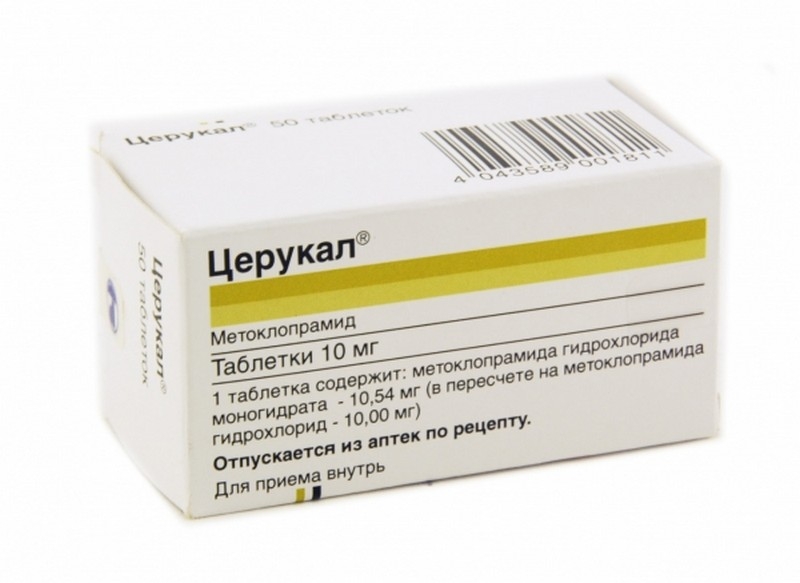
The active ingredient of Cerucal is metoclopramide. This substance blocks the action of serotonin and dopamine receptors, and also suppresses nerve impulses in the brain. As a result, the tone of the gastrointestinal tract muscles is normalized and the gag reflex is eliminated.
The medicine is produced in the form of injections and tablets. It is recommended to take this drug per day in an amount not exceeding 25 mg of the active substance. It is not indicated for use in children under three years of age, due to the fact that metoclopramide hydrochloride has negative side effects on health at this age. Cerucal is taken half an hour before meals.
Motilium for children

The active substance of this drug is domperidone. This antiemetic is taken 20 minutes before meals and is quickly absorbed. Dosage form: tablets and suspensions for oral administration. In the form of a suspension, the drug is approved for children from birth. Tablets are indicated only when the child's weight is above 35 kg.
Enterofuril for children
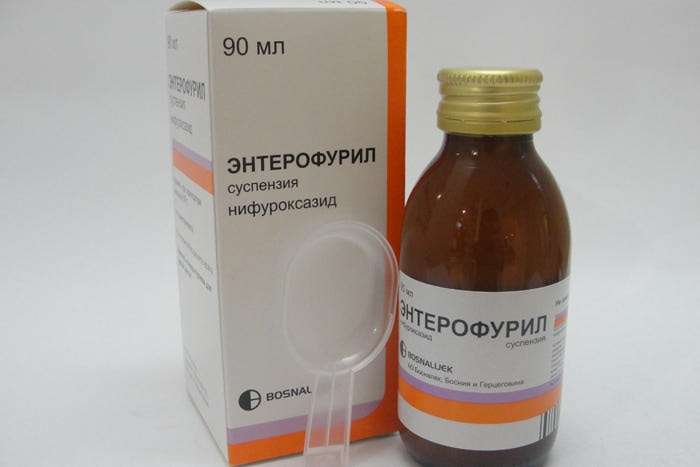
An antimicrobial agent whose active ingredient is nifuroxazide. Available in the form of capsules with a soluble shell and suspension. Recommended for children from one month. Up to seven years of age, it is taken in the form of a suspension. The dosage is selected individually depending on the age category. The drug is not absorbed by the body, so it is not recommended to combine it with taking sorbents for vomiting and diarrhea. The main side effect is that this drug causes dysbacteriosis.





